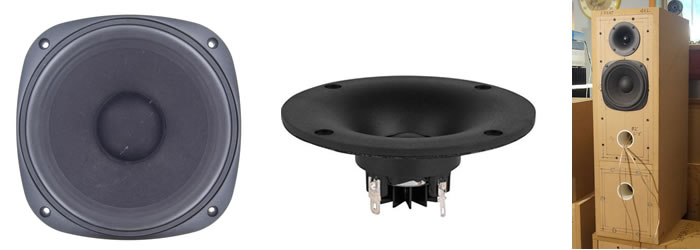|
Lark DCR2 (Dual Chamber Reflex)
SB Acoustics SB16PFC25-8 with Dayton ND25FW-4
It was in June of 2018 that I tested these two drivers in an active bi-amp setup. The result was encouraging. As promised, this is the passive version. In some ways, this is a more refined version compared to the earlier active one. And it all centers on the Dayton ND25FW-4 tweeter.
 Fig 1 – Frequency Response of Dayton ND25FW-4 Fig 1 – Frequency Response of Dayton ND25FW-4
The Black plot in Fig 1 is the RAW response of the Dayton ND25FW-4 tweeter. It doesn’t look very smooth. Because of that, it may be scary for some people. The Red plot is with a 18dB/oct high pass filter and a EQ network to flatten the response. My crossover corner frequency is 2.5kHz.

Fig 2 – Blue plot = SB16PFC25-8. Red plot = ND25FW-4
Measurements below 500Hz are in Nearfield.
Fig 2 shows the response of the SB Acoustics SB16PFC25-8 with a 12dB/oct Low Pass filter (Blue plot). I’ve not made any attempts to remove the slight peak at 4.5kHz. If it’s offensive during auditioning, I will have no choice but to install a conjugate network. As for the ND25FW-4 tweeter (Red plot), I also refrained from installing another conjugate network to reduce the resonant peak at 1.3kHz. Hence, the shoulder at about 1.5kHz.

Fig 3 – Summed Response with ND25FW-4 wired in Absolute Phase
The Black plot in Fig 3 is the summed response of the SB16PFC25-8 and the ND25FW-4. The two drivers are crossing acoustically at about 2.8kHz. No cancellations are observed on either side of the crossover frequency, indicating a proper summation. As I expected, a light hump is seen at 1.5kHz. This comes from the shoulder of the ND25FW-4 tweeter. A similar hump shown at 4kHz. This is from the SB16PFC25-8 peak at 4kHz. There is a good chance that I won’t be able to hear them as both are about -12dB below the fundamental.
 Fig 4 – Lark-DCR2 Frequency Response. Measurements below 500Hz are in Nearfield. Fig 4 – Lark-DCR2 Frequency Response. Measurements below 500Hz are in Nearfield.
The final frequency response of the Lark-DCR2 is in Fig 4. The response is remarkably flat. The ND25FW-4 tweeter extends to about 16kHz before dropping off sharply to 20kHz.
 Fig 5 – Null response. Dayton ND25FW-4 wired in Reversed Phase. Fig 5 – Null response. Dayton ND25FW-4 wired in Reversed Phase.
Fig 5 shows the Dayton ND25FW-4 tweeter wired in Reversed Phase. This created a symmetrical, broad null centered at about 2.9kHz. Though the null does not indicate time alignment of the midwoofer and the tweeter, it does show that their acoustic centers are quite close.
 Fig 6 – Lark-DCR2 Step Response Fig 6 – Lark-DCR2 Step Response
The Step Response in Fig 6 shows the tweeter is leading the midwoofer. If the two acoustic centers are aligned, there will be only one transient. The gap between the two transients represents the delay.
 Fig 7 – Lark-DCR2 Waterfall Fig 7 – Lark-DCR2 Waterfall
From the waterfall plot (Fig 7), there’s negligible artifacts above 6kHz. Just below that, there seems to be some extended decay at 5kHz.
 Fig 8 – Lark-DCR2 Toneburst Energy Storage Fig 8 – Lark-DCR2 Toneburst Energy Storage
Fig 8 reveals the decay as stored energy. There’s a main burst at about 5kHz. This ringing is likely caused by the peak in the SB16PFC25-8 (Fig 3). The secondary burst at about 1.5kHz is probably the ND25FW-4 tweeter ringing at resonance.
 Fig 9 – Lark-DCR2 Spectrogram Fig 9 – Lark-DCR2 Spectrogram
The spectrogram in Fig 9 depicts the decay in a 2-dimensional time/frequency scale. The Lark-DCR2 is exceptionally clean from 2.5kHz onwards. The effects of the ND25FW-4 ringing is clearly visible at 1.5kHz (yellow patch at 4 msec). So, the peak in the SB16PFC25-8 doesn’t present a problem whereas the Fs of the ND25FW-4 may be an issue. I can only confirm this after auditioning.
 Fig 10 – Red plot = 2nd Harmonic. Violet plot = 3rd Harmonic. Fig 10 – Red plot = 2nd Harmonic. Violet plot = 3rd Harmonic.
The 2nd (Red) and 3rd (Viole) harmonics are seen in Fig 10. On average, they are -55dB below the fundamental. No anomalies are seen. However, there’s a 3rd harmonic rise at 1.5kHz. This is not serious as it’s only 5dB. What I didn’t expect is it’s coming from the SB16PFC25-8 midwoofer, not the ND25FW-4 tweeter.
Lark-DCR2 Sound Quality
Smooth and polite would be the best words to describe the Lark-DCR2. The midrange doesn’t shout at you. Neither is it recessed into the background. The Dayton ND25FW-4 tweeter does its job well. No harshness. The dual chamber reflex adds a bit of punch in the 100Hz region.
For a 2-way using budget drivers, the Lark DCR2 is only slightly above average. This kind of sound doesn’t excite me. There’s not enough life in the music. Perhaps upgrading the drivers to more expensive ones will help but that’s not the path I wish to take now. I believe I can make these drivers sing. More to come.
Note: Unless otherwise stated, all measurements were made with the mic at 36 ins, tweeter axis. Impulse Window=5ms. No smoothing applied. |

 Fig 1 – Frequency Response of Dayton ND25FW-4
Fig 1 – Frequency Response of Dayton ND25FW-4

 Fig 4 – Lark-DCR2 Frequency Response. Measurements below 500Hz are in Nearfield.
Fig 4 – Lark-DCR2 Frequency Response. Measurements below 500Hz are in Nearfield. Fig 5 – Null response. Dayton ND25FW-4 wired in Reversed Phase.
Fig 5 – Null response. Dayton ND25FW-4 wired in Reversed Phase. Fig 6 – Lark-DCR2 Step Response
Fig 6 – Lark-DCR2 Step Response Fig 7 – Lark-DCR2 Waterfall
Fig 7 – Lark-DCR2 Waterfall

